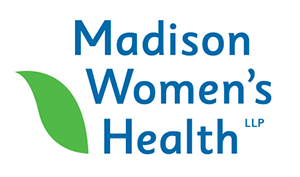Just as every pregnancy is unique, every birth is, too. Some women use pain medications, others do not. Some women labor for a couple of hours, and others for 24 hours or more. Some women deliver vaginally, while others deliver by C-section. For some women, a C-section is their choice. For others, it is medically necessary for their health or the health of their baby. In the U.S., the C-section rate is about 30%. In Wisconsin in 2019, the rate of C-sections was 26%.
One of the topics that will come up in your prenatal appointments with your OBGYN is a C-section versus vaginal delivery (also sometimes called a “natural birth”). Your doctor will ask if you have a preference and if one or the other may be medically necessary.
When we talk about delivery options, some women are skeptical or afraid. It’s OK to feel those emotions and to ask questions. In fact, we’re glad to answer your questions — that’s why we’ve created this article. We hope that our candid answers can help alleviate your fears.
Why Do Women Receive C-Sections?
Women receive a C-section for one of two reasons: 1) it’s their preference 2) it’s medically necessary for either them or the baby.
That’s it.
OBGYNs don’t have a hidden agenda or a quota of C-sections to perform. They don’t get to go home sooner if a baby is born via C-section. In fact, our preference is that every birth could be a vaginal delivery. But sometimes, C-sections are simply the best, safest choice. We always make sure the benefits outweigh the risks before recommending it.
Ultimately, the decision is yours.
A woman may choose to have a C-section because:
- she is afraid that vaginal delivery will be too painful
- she doesn’t want to worry about the baby experiencing stress during labor
- she doesn’t want to have vaginal tears
- she knows when she will meet her baby
- she had a C-section before
Other times, women receive a C-section because it becomes medically necessary. Sometimes, it will be an emergency decision. As often as possible, we want to give you time to discuss the situation so you understand why we may recommend it. That way, it is truly a joint decision with you and your OBGYN.
The most common medical reasons a woman receives a C-section are:
- If labor is not progressing on schedule:
Called “failure to progress,” this means that either the cervix isn’t dilating or the baby is not descending into the birth canal after a significant amount of time. Usually, this is because of fit—the baby is simply too large for the birth canal. - If the baby is breech:
When a baby is in breech position, his or her bottom or feet are down instead of their head. A breech baby birth presents more risks, such as injury to the baby’s hip and thigh during delivery. The umbilical cord could flatten during a breech birth, which could reduce oxygen to the baby and cause brain or nerve damage. - If the baby is showing signs of stress during labor:
A fetal heart rate monitor will help your OBGYN see how your baby is handling delivery and if intervention is needed. - If the placenta is covering her cervix (placenta previa):
This could cause bleeding during pregnancy and unsafe, severe bleeding during labor. - If she previously had surgery on her uterus.
- If she previously had C-sections.
A woman can receive a C-section at any point in the labor or delivery process, whether she is at 0 cm dilated or 10 cm.
Which is safer, C-section or vaginal birth?
Both forms of delivery can be safe, and both can carry different types of risk.
C-Section Benefits
There is no injury to the pelvic floor with C-section delivery. A C-section can prevent vaginal tears. And a C-section can speed up delivery when the baby is showing signs of stress, if the baby is not progressing down the birth canal or if the baby is in a dangerous position for delivery.
The C-section itself is not painful. If the C-section was planned, the woman would get a spinal injection before the surgery to numb the area. If the woman labored first, she would receive an epidural catheter. During the C-section, she would feel tugs and pressure, but would not feel pain.
C-Section Risks
Even though C-sections are one of the most common surgical procedures in the U.S., the fact that they require surgery means they do carry some risk. The biggest risks include blood loss (twice as much as vaginal delivery) and the risk of infection at the incision site. Each C-section also increases the risk of scar tissue build-up, which can increase the risk of the placenta attaching to a scar in the uterus instead of the uterine wall.
Vaginal Birth Benefits
As the baby progresses down the birth canal, amniotic fluid in their lungs gets squeezed out. This helps the baby breathe more readily on their own after birth. As the baby passes through the vagina, they are also exposed to good bacteria, which can improve their microbiome and boost their immunity.
Vaginal delivery is best for a woman who wants to have several children.
Pain relief during vaginal delivery is possible by using medications or non-medicated methods.
- Read more about pain management during birth.
- Read more about epidurals.
Vaginal Birth Risks
Vaginal birth also carries some risk, such as blood loss and risk of infection. Other risks include the baby being unable to fit in the birth canal, pelvic floor injury, vaginal tearing, and umbilical cord accidents.
A vaginal birth after a C-section (VBAC) is possible, even after two or three C-sections, but it also carries some additional risks with labor. Uterine rupture, which is where the scar from the C-section breaks open, is one of the risks of VBAC. While it is rare, occurring in less than 1% of women, it is dangerous. Your OBGYN will monitor you closely during labor.
Whether you can have a VBAC depends on the reason(s) for your previous C-section, where the incision was made, whether you had other surgery on your uterus, how many C-sections you’ve had, when you last gave birth, and other reasons. Your OBGYN will discuss these factors with you to determine the safety of a VBAC in your situation.
Which form of delivery has the best recovery?
Just like nearly everything about pregnancy, the answer to this question is “it depends.” Some women recover faster from C-section than from a vaginal delivery, and other women recover more quickly from a vaginal delivery than from a C-section.
Here are some points to consider:
C-Section Recovery
Because a C-section is a surgery, more pain medications are usually needed during recovery. Usually, women receive ibuprofen, Tylenol, or even narcotics for the first 3-7 days. (Any pain medications prescribed would still be safe for breastfeeding.)
Activity after a C-section is more limited. A woman who has a C-section shouldn’t lift anything heavier than her baby for about six weeks. She should receive help around the house and caring for any other young children. She shouldn’t drive for about two weeks or while taking narcotics.
Women who labored before receiving a C-section generally have the longest recovery time. Not only do they need to recover from the surgery, but they also need to recover from the labor itself.
C-sections themselves don’t affect weight loss after birth, however a longer time of remaining less active will make weight loss more challenging.
Vaginal Birth Recovery
Because surgery isn’t involved, recovery is generally shorter. Soreness and discomfort usually last for a few weeks but can be treated with over-the-counter pain medication, such as ibuprofen. Your OBGYN typically will recommend that you do not exercise strenuously for six weeks. Taking it easy for six weeks after delivery helps to support your pelvic floor muscles while they heal.
Talk to your OBGYN about C-Sections and Vaginal Births
At Madison Women’s Health, we want you to feel comfortable and well-informed about your decisions.
During your prenatal check-ups, we will talk to you about vaginal birth (which some people call “natural birth”) and C-sections. We will give you our recommendation based on your health history. And we will support the decision that you make.
If it becomes medically necessary to change from your original birth plan, we strive to explain the reasons behind our recommendation so you can continue to feel supported throughout the birth of your child. Our goal is always to have a safe and healthy delivery, resulting in a healthy and thriving mom and baby.
 Dr. Ashley Durward has been providing healthcare to women in Madison since 2015 and joined Madison Women’s Health in 2019, specializing in high and low risk obstetrics, contraception and preconception counseling, management of abnormal uterine bleeding, pelvic floor disorders, and minimally invasive gynecologic surgery.
Dr. Ashley Durward has been providing healthcare to women in Madison since 2015 and joined Madison Women’s Health in 2019, specializing in high and low risk obstetrics, contraception and preconception counseling, management of abnormal uterine bleeding, pelvic floor disorders, and minimally invasive gynecologic surgery.



